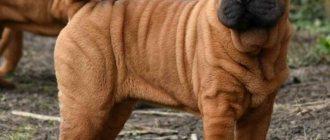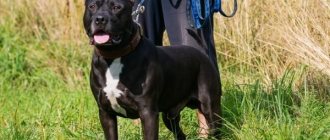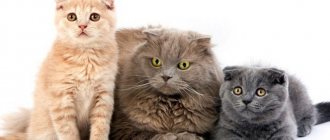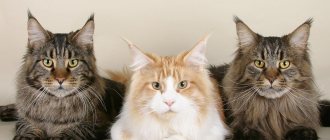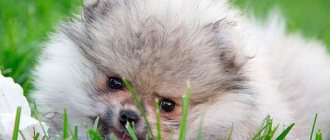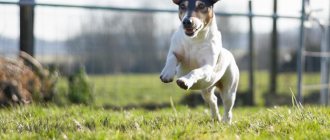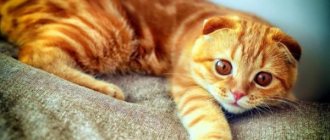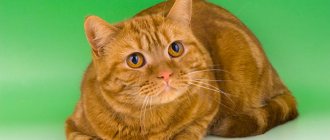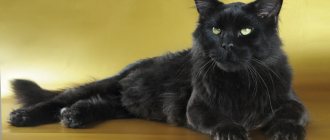To designate the “raccoon cat” standard, felinologists have adopted the EMS code system. Breeders study the genetic predisposition of pets to a certain color and fur pattern. The main names and their variations have been studied, depending on the tone, location of stripes and figures on the wool. The expected shade of the pet's eyes is known.
Maintenance and care
Despite the fact that this breed of cat tolerates harsh climates well, the owner of large animals will need to pay a lot of attention to them.
The main nuance of maintenance is Maine Coon fur care. Since there is quite a lot of it, in addition, it stands out due to its length, in order to prevent tangles, the cat will need to be combed regularly. A suitable comb is a blunt-toothed comb. It is recommended to perform such procedures every other day. Long-haired breeds are also recommended to be bathed with shampoo once every 6 months. The animal's claws require attention. As they grow, the ends should be trimmed, avoiding removing the living part where the capillaries are located.
As a kitten grows, its teeth change, but caring for the animal’s oral cavity is mandatory at any time. For these purposes, use a special toothpaste and brush.
Hygiene measures will also apply to the ears. The ears are subject to regular inspection; if various types of dirt are found in them, they are cleaned with a damp cotton sponge. You should avoid using sticks or matches with cotton wool. Cats' eyes should be wiped with a damp swab using boiled water.
Big cats themselves are noted for their cleanliness, so they constantly lick their fur. To help your pet get rid of hairballs in the stomach, specialized pastes are sold for animals that help cleanse themselves from the inside. Neglecting such remedies can lead to constipation and coughing in your cat. In addition, Maine Coon owners are recommended to grow a “cat garden” at home, which will help them cleanse the body on their own.
Cats at any age will be interested in entertainment, in addition to spending time in the arms of the owner. For these purposes, it is worth installing scratching posts, labyrinths and ladders at home, as well as shelves, beds and other interesting devices designed for active pet play. Otherwise, the Maine Coon will use curtains, cabinets and sofas as “sports equipment”.
For cat litter, you can purchase special litter or sand, but cleaning the litter box should be regular in light of the large size and smell of feces of both Maine Coon boys and girls.
The issue of cat nutrition should be approached thoroughly. It is best to individually select dry food for your Maine Coon together with a veterinarian or breeder. However, the animal will also actively and correctly develop on natural food. Super class food will already contain the necessary vitamins for a member of the cat family. When choosing a different type of feeding, your pet’s diet should include raw and boiled beef, chicken, and turkey. You should avoid fatty meats.
The animal should also be given lean fish, dairy and fermented milk products, and boiled eggs. It will be possible to replenish the supply of essential microelements by including sprouted grains in the diet. Vegetables and cheese can also be given to pets. Your Maine Coon will need clean, fresh water. To select the optimal portions of food, you can use a special sign that will indicate the weight of the kitten and its approximate menu.
The optimal age for mating is one and a half years. Maine Coons typically have 1 to 6 kittens per litter per year. Cats have very developed maternal instincts, so they show amazing care for newborns. If the breeder for some reason does not want to breed cats, then castration is carried out for males. It is best to castrate an animal before the age of one year. Cats are sterilized.
Solid Maine Coons (black, white)
When a Maine Coon's color consists of only one color, it is called solid. This color is produced by suppressing recessive genes. If the pattern is not completely suppressed, leaving a fuzzy shadow tabby.
Cream and red colors do not effectively suppress tabbies. Maine Coons of this color will certainly have patterns on their body, to one degree or another.
The monochromatic white color is obtained due to the influence of various genes that can suppress colors. White kittens often have shades of stripes on their heads in the first months of life. This is explained by incomplete suppression of color. But with age everything goes away.
Breed Features
Representatives of this species have a rather unusual appearance. They have a powerful build, graceful muzzles and tufted ears that make these pets very similar to lynxes.
Also, these cute animals have large and beautiful eyes. Although they are a little askew, this does not detract from the majesty of the representatives of this breed. Typically, their eyes are green, but can also be amber or golden. About Maine Coon cats in the description of the breed it is said that they have a rather powerful chest.
This breed is considered one of the few species of natural origin. Therefore, it cannot be said about these kittens that they were individually bred. Due to the fact that in the state where they were bred it is quite cold, such animals have a warm coat that protects their body well in the cold season.
Since such cats often walked in the snow, their paws are rough with fur between the toes, which also warms them.
Representatives of the Maine Coon breed can reach up to 110 centimeters in height. Their weight can be up to 4-8 kilograms if they are cats, and from 8 to 12 if they are cats. A purebred pet's head is slightly elongated, with raised cheekbones near the muzzle. They can live from 15 to 20 years.
Speaking about representatives of a particular breed, it is extremely important to note their characteristics
The Big Maine Coon is also no exception and certainly attracts attention. Indeed, the peculiarity of the cat lies in its incredibly large size, long hair and muscular, strong body.
The shape of the animal's chest is rectangular. The animal's head is large, and its muzzle features are expressive. A powerful neck of medium length only adds to the animal's stature.
The characteristic features of a cat are its ears, which are pointed at the ends. It is by these that the Maine Coon breed is most often recognized. Black, red or any other color of this animal does not go unnoticed.
What else can you say about the favorite of many pets? Perhaps the fact is that the Maine Coon, videos of which are presented in large numbers on the Internet, has very beautiful, expressive eyes.
Their color is usually green or golden. And their peculiarity is a slight slant.
Paws, when it comes to Maine Coon, the description of this breed also deserves attention. Cats have them - long and strong, incredibly strong, such that they can definitely withstand the weight of an adult.
The hair tufts located between the toes are also a kind of feature of the presented animal.
It is quite possible that its development is a consequence of adaptation to the harsh Russian winters (as well as long hair). The Maine Coon's tail is very fluffy and also large, conical in shape. Its peculiarity is its pointed end.
Interesting fact about animal fur. Long in the main part, on the shoulders and head it is, on the contrary, very short. The longest hairs are observed in the abdomen, on the back and sides. The undershort also has a dense pile that does not allow cold wind to pass through.
Smoky colors (Smokis)
If the cat is black or blue in color, but the roots of the hairs are clearly white, then it is “smoke”. Solid-colored cats usually have grayish hair roots; true smokes have distinct white roots. Smokes are a solid variant of the silver tabby. This color is very mysterious and impressive, especially in movement with a beautiful play of color.
Smoky colors are divided according to the length of the dyed hair into the following types:
Chinchilla
– 1/8 of the hair tip is dyed.
Shaded
– 1/4 of the end of the hair is dyed.
Smoky
– 1/2 of the end of the hair is dyed.
Black smoke
- black color with white roots.
Blue smoke
– blue color with white roots.
Silver (Shaded/Chinchilla)
- at birth, kittens have fur so light that it appears white. White color can only be inherited from white parents (not silver). A small tabby pattern is sometimes possible at the tip of the tail, which usually disappears by six weeks. A sign that the kitten is silver and not white is green eyes.
Red (cream) shaded or smoky color Cameo (Cameo)
— kittens of this color are usually born white, and tipping appears gradually.
Maine Coon cat, black smoke color MCO ns
Maine Coon cat color blue smoke MCO as
Maine Coon cat, red smoke color MCO ds
A little history
These kittens are known for their high intelligence and self-confidence. The very name of this breed translates as “cat raccoons”. Indeed, their coat is very similar to that of raccoons.
Thanks to climatic conditions, Maine Coon kittens have such a thick coat. In the places where representatives of this breed were bred, the main emphasis was on agriculture. And such animals helped in becoming excellent mouse hunters. Therefore, the goal of the breeders was to breed pets that would be huge in size and lead an active lifestyle. This is exactly how these kittens turned out.
Starting from the 50s of the 19th century, Maine Coons began to take part in various cat shows. Thanks to this, such animals have become quite famous in many large and small towns in America. This breed began to compete with other known species. They were as popular as Persian or Angora cats.
But already in the twentieth century, interest in such cats began to gradually fade away. These animals again became helpers in the household. And starting from 1953, the breeding of representatives of this breed began to be actively pursued again. Thus, cats have become popular again not only in the USA, but also in other countries and continents. They again began to take first place in the ranking of furry animals. Many people began to purchase them so that their pets would please their eyes and become friends for all family members.
Maine Coon, the description of the breed, perhaps encourages many animal lovers to find out as much information as possible about the pet. Thus, it is known that the approximate time when people started talking about the breed seriously was no less than half a century ago.
It is quite possible that the Maine Coon, whose video is very popular on the Internet, is the result of a successful crossing of short-haired cats living in New England, in Maine, with imported long-haired cats that came to the territory thanks to the movement of traders. However, this, again, is one of the well-known versions.
It was widespread in America in the nineteenth century. It is worth saying that at that time Maine Coon kittens, whose photos now cause delight among many, did not attract the public attention they deserved. And this lasted until the breed was presented at the exhibition.
It is known that the black Maine Coon received a winner's medal, which has been preserved to this day and is in the CFA club.
With the advent of the nineteenth and twentieth centuries, cats with pointy ears again became unpopular, and interest in them fell sharply. What this is connected with is unknown.
But, a few years later, already in the mid-twentieth century, fans of the Maine Coon animal began to correct the situation. Their photos were collected and presented in specialized clubs.
And what pushed them to take such a serious step was the announcement that the breed could be considered extinct... Thanks to considerable efforts, by 1956 it was possible to create a standard for individuals of this breed.
Almost twenty years later, the club was considered a serious organization and was treated with due respect. Currently, the adult Maine Coon ranks third in popularity. At the same time, it is worth adding that the first two places belong to exotic cats, the interest in which is quite obvious.
Features of colors
This cat breed can be classified as the largest domestic animal, which can boast not only of its grace and size, but also of strength, good-natured character and intelligence. In total, breeders developed 6 coat colors of these cats. This breed took a long time to develop, limited populations were crossed here, and the natural colors of black marbled and black brindle tabby were obtained. Today, breeders have begun to breed a huge number of colors of this breed, and every day the population is growing and replenished with new shades of wool.
There are several especially valuable Maine Coon colors:
- monochromatic coloring of cats, it is the rarest;
- Tabby color is natural, so only brindle and merle are found.
There are also solid colors that were obtained as a result of the hard work of breeders, these include:
- white, there are no pigment spots in the fur, and kittens have gray spots that disappear after the individual grows up;
- black, there is practically no visible pattern, but if you look closely, you can see a barely noticeable pattern, but it is indistinguishable;
- the red color does not have light hairs, it looks more red, the shade is completely painted over, red Maine Coons have a clear pattern and the pigment is more saturated;
- The most solid color among Maine Coons is considered to be blue, while the coat has a gray-blue tint with no ornamentation;
- Pure cream color of cats is not found in Maine Coons, that is, there are still visible pigment spots on the fur.
Now it’s worth considering some types of Maine Coons, habits, type of coloring, what they are, and also a few words will be said about caring for this breed of cats.
Tan, red and cream
Each type of these cats is majestic in its own way, and no matter what shade your cat has, ginger cats have a particularly striking appearance. The red shade refers to solid colors; the coat has a uniform dark red color. But light stripes still appear on the coat, in this case the result is a tabby shade. In addition to the usual red color, there is also a brindle coloring; visible dark stripes appear on the surface of the body.
This type of color also includes the creamy shade of Maine Coon fur; it appears on the head, body and tail of the cat. Pure cream color appears very rarely in the population; there is still a visible pattern.
Black and smoke
The pattern on black marble wool is the same in location as that of red marble, only here it will not have stripes, but unusual patterns on the brown skin. The smoky color of cats is a white or light basal surface. And when the cat begins to move, this coloring becomes more noticeable. This color includes the following color types:
- blue;
- black;
- red;
- tortoiseshell.
This color also has differences in the length of the coat and its color:
- 1/8 of the wool is dyed - this is the color of chinchilla;
- if it’s 1/4, then it’s a shade;
- It can be considered smoky if half of the coat is dyed.
Tortoiseshell
These cats have multi-colored fur, spots are scattered in a chaotic manner throughout the body, predominantly black, white and brown. Most often, a Maine Coon cat has this color; all this happens at the genetic level during crossing.
Calico
These are white cats with beautiful red and black spots on a white background all over the surface of their fur. They differ from tortoiseshells in that they have spots on the black coat.
Black marble
It is the marbled coloring of Maine Coons that is highly valued, since the color is very similar to real marble. The merle Maine Coon color is very common as a natural coloration. To choose a Maine Coon kitten, there is a certain table of color designation and color markings. Using such a table, you can choose an animal without looking at the kittens live or from a photo. In this breed, only the color of the eyes is not marked, since here the iris can be of any color.
Color classification
All colors of Maine Coon cats can be divided into categories: with a pattern or tabby; without a pattern or solid; tortoiseshell; smoky and silver.
Drawing (tabby)
The Maine Coon Tabby has the following traits:
- stripes on the forehead in the shape of the letter "M"
- eyes and nose mirror are outlined in dark
- there are dark stripes on the sides of the muzzle
- stripes on the chest form a “necklace”
- horizontal stripes on paws
- small spots on the belly
The drawing itself comes in 4 types:
- Marble or classic (blotched/classic). There are rounded marks on the sides; a “butterfly” is possible between the shoulder blades. And solid lines along the spine.
- Tiger (mackerel). There are solid vertical stripes on the sides and a dark stripe along the spine.
- Spotted. Pattern in the form of small spots or dotted stripes.
- Ticked. The drawing is only on the face. Each hair ends in a dark color. The ticked color of Man-Coons is not typical and is typical of Oriental breeds.
People often use the name “wild” or “forest”. Underneath is the black marbled color of the Maine Coon n22.
n 22 – black marbled tabby
n 23 09 – black brindle tabby with white
d 24 – red spotted tabby
a 25 – blue ticked tabby
Solid (solid)
A solid colored cat should have a uniform color throughout the body. Breed standards assume that the coat color is rich and the hairs are dyed from base to tip. The disadvantage is the residual pattern, including on the head, as well as a lighter undercoat (than the main color). Markings of a different color are considered defective.
In Maine Coons, solid is represented by 5 colors:
- Black
- Red
- White
- Blue
- Cream
Some colors are not allowed in the breed standard. The unrecognized colors of the Maine Coon are: gold, chocolate, cinnamon, fawn, lilac and color point.
The black Maine Coon cat has a stunning look. It needs to be combed more often than others. This way, fur renewal occurs faster and dead brown hairs do not remain. This is especially true during the molting period. For a healthy and beautiful coat, you need to provide your pet with proper nutrition. Maine Coons with a black coat are the most difficult to prepare for a show. Dead hairs are brownish in color, while new ones are gray, which darkens over time. You need to make sure that the wool in the collar area and on the “pants” does not have a different color cast.
If a Maine Coon is born black with a white spot, then it is already a bicolor color.
n – black solid
The red color of the Maine Coon includes all shades. Most often you can hear the name red Maine Coon. Due to the strong tabby gene, it is very difficult to achieve the absence of a pattern in a Red Maine Coon. Therefore, it is slightly visible, but still present in the solid.
d – red solid
You can't go past the luxurious white Maine Coon cat. As stated earlier, this color is not a color. This is rather a lack of color in the Maine Coon, because the hair does not have color pigment. A small kitten may have color markings on its face that fade over time. Pets are not fussy to care for. White Maine Coons come with blue eyes and multi-colored eyes (one is blue and the other is green). The completely green iris of the eyes is characteristic of the silver color (description below). It is worth noting that such kittens have a risk of being born deaf. Therefore, it is better to choose a snow-white miracle from experienced breeders: crossing two white individuals is prohibited.
w 62 – white with yellow eyes
Maine Coons of the blue solid color are not very common in the CIS countries. Their fur is ash-gray in color, with a certain blue tint. Probably because of him, blue Maine Coons became popular in Europe.
a – blue solid
The cream Maine Coon is obtained by lightening the red color. The color has warm shades of ginger. Achieving pure colors is problematic due to the progression of classical genes in the Maine Coon.
e – creamy solid
Tortoiseshell
There is an opinion that cats with a combination of several colors bring good luck. A black tortoiseshell Maine Coon can be a torby or a tortie depending on the number of colors. Torbi includes red and black (brown). Torti adds cream color. The lightened classic tortoiseshell coloring is called blue-cream.
Interesting! Most cats are born with tortoiseshell coloration. The chance of having a boy is 1 in 1000.
Tortoiseshell cats can be additionally smoky or silver.
f 22 – black tortoiseshell marbled tabby
g – blue-cream tortoiseshell solid
In addition, the color may be missing or have white markings of varying sizes. A Maine Coon with white spots that have distinct edges is called a calico. Translated as “chintz” or “flap”. Calicos are characterized by the presence of red spots with a pattern. Blue-cream Maine Coons, with a spotted pattern or diluted calico (calico) may also have white markings.
f 09 – black solid turtle with white
Silver and smoke
Smoky Maine Coons always produce an impressive effect. A distinctive feature of the color is the presence of a perfectly white root zone in the coat. Do not go with a lightened or grayish color.
Smoky coloring has its own categories:
- normal – hair is half dyed
- shaded – the hair is colored by a quarter
- chinchilla – one-eighth of the hair is dyed
Black Smoke Maine Coons, like Blue Smoke, have a rich base color along with white roots. Tortoiseshell can also be smoky.
ns – black smoke
If a cat with a white undercoat has a pattern, then this color is called silver. As a rule, such kittens are born very light. As they grow older, the fur begins to darken and the pattern becomes brighter. Coloring is determined at a young age by eye color. The silver color has green eyes, and the blue color has white eyes.
fs 22 – black silver tortoiseshell marbled tabby
In red smoke (silver) kittens, the coat pigment is weakly visible. They are born light-colored, which is why they are called “cream” or “cameo.”
ds 23 – red silver (cameo) brindle tabby
White spots
White spots can be in addition to the main color. Depending on the size and location, the division occurs:
- Van is an almost white individual with several spots on the head and tail, and occasionally on the body.
- Harlequin - Larger spots of color are located on the main white background.
- Bicolor (bi-color) – the ratio of white and main color is 50/50.
- Locket - a white spot located on the chest.
- Gloves (mitted) – white spots on the ends of the paws, as if wearing “socks”.
- Tuxedo (tuxedo) – white spots are located on the chest and paws, possibly on the head.
- Buttons – several small white spots.
n 03 – black and white bicolor
n 01 – black and white van
In conclusion, we can say that Maine Coons do not have rare colors. Even a red Maine Coon or a black merle can be rare if they are unique based on the coloring of their parents. You also need to understand that the same color will look different on two kittens.
Origin story
Maine Coons boast a rich 150-year history. Much is known about the development and formation of the breed, but the appearance of such large cats in the north of America is shrouded in secrets and legends. One of them says that cats are the fruit of love between a cat and a raccoon. From the latter they inherited their large size and striped tail. According to another legend, Maine Coons have the blood of North American lynxes. As proof of this version, many cite the well-known tassels on the ears. However, the truth is that they are the result of selection; 100 years ago many representatives of the breed did not have these tassels, and even today not everyone has them. Realistic felinologists believe that, first of all, this is a population of domestic cats that formed naturally. Over the decades, these cats have been honed by nature itself, which has made them physically hardy and large animals, perfectly adapted to harsh winter conditions and hunting.
Since ancient times, “raccoon” cats lived on Maine farms and fought with numerous rodents, protecting grain supplies. But only the hardiest and largest individuals with well-developed muscles and gorgeous appearance took part in further targeted selection under human guidance. Maine Coons are rightfully considered the national pride of America. Since the mid-19th century they have already begun to be talked about as a separate breed. At one of the fairs, farmers even organized an exhibition where Men's raccoon cats competed for the title of Meime State Champion coon cat. Undoubtedly, this speaks of their high popularity and love of the local population. Further, large cities also became interested in cats from Mena. They began to appear at exhibitions in Boston and New York, where they competed with another popular breed at that time - the Angora cat.
In 1895, at the Madison Square Garden New York cat show, the beautiful Maine Coon Kuzi became a star and received the title Best of Show. It was a brown tabby cat (initially only those could belong to the breed, but later the palette expanded significantly). In 1908, at an exhibition organized by the CFA in Boston, the fifth Maine Coon was registered, his name was Molly Bond. Over the next 10 years, the popularity of the breed grew exponentially, they began to be exported to other countries and actively improved their external characteristics. However, since 1911 there has been a lull. For 40 years, Maine Coons have not appeared at any specialized exhibition. Apparently, this was due to the emergence of other, more interesting breeds.
Thanks to the enthusiasm of raccoon cat lovers from 1966 to 1968, a breakthrough was made and the champion title was returned to the giant. In 1968 there were six, which is still in operation today. In 1976, the Maine Coon breed was officially recognized, and by 1980 about 200 nurseries and thousands of fanciers were registered. There were certain standards and Maine Coons began their triumphal march around the world, winning the hearts of millions with their incredible appearance and peaceful nature.
Video review about Maine Coon cats:
Tortoiseshell Maine Coon and tabby patterned
It often happens that the Maine Coon breed has completely random combinations of colors and shades. Then the color can be called:
- Tortoiseshell - spots of various colors and sizes are scattered all over the cat’s body, with the exception of white: black, red, cream;
- Tabby spotted brown is like falling leaves in the fall. Numerous areas of brown and red color on the Maine Coon's body. The color is also called torbie;
- Blue-cream . The body of the Maine Coon is covered with spots of pastel colors. They have blue and cream shades. This color is also called blue turtle;
- Blue spotted tabby . It is a delicate color with patches of blue and cream tabby.
Appearance and standards
Maine Coon cats are considered the largest breed of domestic cats and for good reason. After all, they often reach a meter, or even more, in length (from the tip of the nose to the tip of the tail). Imagine:
- powerful chest;
- strong paws;
- impressive size wedge-shaped head.
The effect is further enhanced by long thick hair - this is the Maine Coon in person. Of course, cats are somewhat different in size from cats with an average weight of 8 kg, but only from cats of their own breed, in relation to other breeds, they will still be much larger.
Head and muzzle
The Maine Coon's head is proportional to the body, massive and large. The square-shaped muzzle is clearly defined. A smooth concave slope is noticeably visible in profile. The forehead is gently curved. The nose is of medium length and width. The cheekbones are prominent and high. The chin is square and powerful, forming a vertical line with the nose and upper lip. The ears are large, wide at the base and moderately pointed at the tips. It is desirable to have “lynx” tassels, and the tufts of hair in the ears should extend beyond the outer edge of the auricle. The ears are set with a slight slope to the outside, high on the head, the distance between them is equal to the width of one ear. With age, a slight increase in this interval is allowed. The eyes are large and set at a distance from each other. The shape is oval, but not almond-shaped. When wide open, the eyes appear round. Any color of the iris is allowed, there is no dependence on color. Clear eye color is highly desirable.
I would like to note that the Maine Coon is recognized by all world felinological associations, in particular WCF, CFA, FIFE, TICA, and the standards adopted by these federations may differ slightly from each other.
Body type
The body is elongated with strong bones and well-developed muscles. The chest is wide and strong. All parts of the body should be in proportion, creating a rectangle. The legs are of medium length, the paws are large. There are tufts of fur between the toes. The tail is long, equal to the distance from the shoulder blades to the croup, tapering slightly towards the tip.
Coat and colors
The coat is thick, water-repellent, and lies tightly to the body. The undercoat is well developed, soft and warm. The length of the hair is uneven throughout the body, the “pants” and “collar” are noticeable, the tail is very well pubescent. The length and thickness of the coat depends on the season.
Cats come in a variety of colors and any markings are acceptable. Conditionally possible colors of Maine Coons can be divided into groups:
- plain (solid or solid);
- two-color;
- tabby (marbled, spotted)
- tortoiseshells (tricolor);
- smoky.
It is worth considering that there is a list of colors that are unacceptable for the breed: color point (Siamese), lilac, chocolate and fawn.
Tabby Maine Coon
Maine Coon colors are called tabby if there are stripes on the animal's coat. They are certainly present on the muzzle, circling the eye sockets and forming the letter M on the forehead. A careful examination reveals that the stripes alternate (light and dark). This combination is called agouti.
There are three main tabby patterns:
- Brindle . The strips are arranged parallel to each other in a vertical position;
- Classic . Stripes similar to marble stains are on the sides. They are wide and spiral;
- Spotted . The Maine Coon's body is covered with intermittent stripes in the form of spots.
Some experts also classify the Abyssinian pattern as a tabby. When there are no stripes or spots on the body, but there is a pattern on the face.
Tabbies come in a variety of colors, the color of the stripes and the tip of the tail being important. The hue of agouti, in turn, varies from pale blue to rich red.
Story
This is not a man-made species at all, but an aboriginal breed created by nature in the northern state of the USA. It was there, in Maine, where the climate is quite harsh, that large domestic cats were born. The result of this increased size is not a gene mutation at all, but due to natural selection.
It is not so easy to survive in harsh climatic conditions; this is only possible for the largest animals covered with warm fur. And so it turned out that from each litter only the tallest and strongest kittens survived. Gradually the breed became larger.
At the end of the eighteenth century, breeders in large cities drew attention to the unusual nature of cats. Local residents have long been accustomed to the fact that their giant assistants do an excellent job of exterminating rodents, but they did not have enough time to think about the unusual nature of their pets
It’s a completely different matter when such specimens fall into the hands of felinologists. The first standards were registered already at the beginning of the nineteenth century. But the peak of popularity and world fame began for them at the end of the century.
Captain Jenks of the Marine Cavalry was the long and unusual name of the first Maine Coon to win the show in 1861. It would seem that this is the moment of glory, but our heroes are crossed by fluffy Persians and all the love and popularity goes to them. But large mousecatchers were appreciated by farmers from all states of America, and due to such demand, the breed managed to survive.
Today they are held in high esteem again. They are loved by families with children, single people, professional breeders and just cat lovers. But we must not forget that these gentle giants have not only advantages, but also disadvantages.
Description of the breed
When we talk about the size of a cat, we mean that its weight can reach eleven kilograms. Agree that such an animal cannot even be compared with the miniature domestic cats that we have become accustomed to since childhood. Their body is large and muscular, covered with long hair and an insulated, dense undercoat. The tail is long and fluffy. The paws are powerful and straight. The ears are wide at the base, tapering towards the tips. The eyes are quite large and oval. Any color of the iris is allowed. As for color, there are strictly regulated restrictions. Absolutely any color with any pattern is allowed.
Knitting features
Mating of Maine Coons is a crucial period for the breeder, the onset of which can be determined with the naked eye: mature cats mark their territory, cats, meowing for a long time, rub against protruding corners and roll on the floor. Maine Coons are allowed to mate after their third heat cycle, between 10 and 18 months. In some cases, the first heat begins early - at the age of 7-8 months. A cat as a male is finally formed by the age of one and a half years, but can be ready for breeding from 8 months.
Mating maintains and improves the breed, so you need to prepare thoroughly for it. Breed-class animals that have taken part in exhibitions and received breeding grades are allowed to reproduce. The best way to find a partner for your pet is to contact a felinological club, where they will select a worthy candidate.
Before mating, it is necessary to examine both animals at the veterinarian for dangerous diseases and check for the necessary vaccinations.
Maine Coon cat colors
Maine Coons come in a variety of colors. Initially, cats had a black marbled color, which made them look like a raccoon. Over time, breeders began to need cats of all colors.
Their work to suppress the genes responsible for color led to the appearance of cats of all colors: solid, brindle or tortoiseshell, and others.
Maine Coons come in different colors
Colors are classified by color, patterns, spots.
Plain
The selection work of scientists has made it possible to develop a Maine Coon breed with a uniform color. As a result of the suppression of genes responsible for color, white kittens appeared. The breed has a second name: solid.
Maine Coon
It means artificial, monochromatic. Most often it is possible to get black Maine Coons, with red cats in second place.
Black
Black Maine Coons come in solid colors and with lines on their fur. They appear on the neck and face of the animal.
Black Maine CoonDepending on the pattern, cats are further divided into three types:
- brindle (vertical stripes run across the entire silhouette),
- marble (reminiscent of stains on marble),
- spotted (stripes are clearly visible).
Maine Coon
There are black Maine Coons with white spots.
The name indicates that the animal's fur combines equal amounts of white and black. Black Smoke cats have no stripes or spots. The coat color is white at the roots, darkening towards the tips.
Depending on the presence of hair of this color, varieties are distinguished:
- chinchilla (black hair up to 1/8 of the fur),
- smoky (even ratio of black and white wool),
- shaded (only a quarter of the hairs are black, the rest are white).
White
White coloring is rare for Maine Coons. Characterized by the absence of wool of other shades. Often white individuals have amazing eyes: blue, bright green, golden.
White Maine Coon
Representatives of the white color do not have characteristic stripes on the tail, but there are tufts on the ears. Kittens have small stripes on their foreheads, but these disappear completely when they reach adulthood.
Red (red)
For a kitten to be bright red, you need two red parents. Red Maine Coons come in solid colors. The name of the color depends on the type of stripes: classic, brindle, spotted, ticked, agouti or smoky.
Red Maine Coon
Kittens appear light and turn red with age. It is impossible to determine which gene will predominate.
Cream
Kittens are also born white; pink pigment begins to color the animal's fur only in adulthood.
Cream Maine Coon
Blue
Blue Solid is common among this breed. If there is no picture, then the gene responsible for them is suppressed. Pure color is rare. In the table it is indicated by one letter.
Smoky individuals are black or blue. The dominant color appears closer to the tip of the hair. At the roots, the hair looks snow-white. This feature of coat color is present in ginger cats.
White marks
Many Maine Coon fans try to breed kittens with touching white spots. This is explained not only by the fact that the markings on raccoon cats look spectacular, but also by the fact that some felinologists consider the absence of white in the color to be a real defect.
White spots on the Maine Coon's coat can be located on any color and be of completely different sizes, but they are always clearly visible, unlike Siamese cats, whose spots are shaded and do not have clear boundaries.
Maine Coons color tuxedo
Maine Coon kitten, harlequin color
Maine Coon with white socks Maine Coon black and white To scientifically describe the color with a white spot, simply add “with white” to the main coat color, for example, black and white or red and white. People often call this color of a cat simply black and white or white with spots.
Color classification of Maine Coon with white spots
| Russian color name | English color name | Color characteristics |
| White gloves | mitted | the presence of white “slippers” on the paws |
| White medallion | locket | the presence of a white mark on the chest, which may resemble a tie, bow tie or even a collar |
| White buttons | buttons | the presence of one or more small spots that have a clear outline |
| Bicolor | bi-color | Maine Coon's coat is exactly half white |
| Harlequin | harlequin | the coat is completely white, except for a few large colored spots |
| Wang | van | the coat is completely white except for the head and tail |
| The tuxedo | tuxedo | a gentleman's set of a beautiful combination of white gloves and a white medallion on colored wool (this definition has not yet been officially recognized) |
Diet
Opinions on the proper nutrition of the Maine Coon differ significantly. Some believe that large cats should be fed only with professional food, others argue that large breeds, especially those of natural origin, should eat only natural food, and others are of the opinion about the benefits of mixed feeding, which is often refuted by veterinarians.
Maine Coon cats are said to have an insatiable appetite, although this fact is still controversial. Of course, they eat an order of magnitude more than their smaller counterparts, but they are not prone to overeating.
Feeding with industrial feed
If you decide to give preference to feed, then it should be high-quality diets labeled “complete nutrition”. Many manufacturers produce lines for adult cats with different needs, so Maine Coons are more suitable for food for active domestic cats, unless there are special requirements. The Royal Canin line has a special diet for Maine Coon cats. In any case, the food must be individually suitable for the pet, and evidence of this will be:
- beautiful appearance;
- excellent health;
- no problems with stool.
Natural diet
If we talk about natural nutrition, then its basis should be lean meat (chicken, beef, veal, rabbit, turkey) and offal (heart, lungs, stomachs, liver). All this should account for about 70%, the remaining 30% are vegetables, fruits and cereals. Every week cats are given low-fat sea fish, a quail egg, and fermented milk products as tolerated. When feeding “natural”, vitamin and mineral supplements are regularly introduced into the diet; this is the only way to ensure adequate nutrition.
For any type of feeding, it is advisable to introduce sprouted oats or special cat grass into the diet.
Adult animals aged 1.5 years or more are fed 2-3 times a day. Kittens from 6 months of age – 3-4 times a day
Particular attention is paid to the nutrition of babies from 3 to 5 months; this is a period of active growth and development, and therefore the diet should be rich in vitamins and microelements. Kittens at this age are fed up to 5 times a day
And of course, your pet should always have clean drinking water freely available.
Numbers and letters in color designation
MSO is the breed itself - Maine Coon . The lowercase w represents the color of the coat. There are many colors and therefore these letters are different. Here are the main notations:
- W – white – white;
- N – black – black;
- A - blue - blue;
- D – red – red;
- E – cream – cream;
- F – tortoiseshell – tortoiseshell;
- G – blue-cream – bluetortie.
When the breed description contains only one of the above letters, it means that the coat has a uniform, solid Maine Coon color. The combination of letters, on the contrary, indicates uneven coloring of the hair.
The designation of patterns on a Maine Coon is made by the very numbers that come after the letter combination. In our case, 22 are marble shades: eye rims, streaks on the sides, stripes along the ridge, streaks on the paws and tail.
23 – Maine Coon brindle color. The pattern will have vertical stripes, similar to a mackerel or tiger.
24 – broken stripes and white spots, etc.
Having looked at the variety of combinations, let's turn to the main types of Maine Coon colors that are most often found.
Unrecognized colors
There are also restrictions on the nature of coloring: colors and patterns that are found in Asian breeds are not recognized in raccoon cats. These include fawn, sorrel, cinnamon, point color, as well as any acromelanic colors. It is believed that oriental blood spoils the massive and powerful backbone of the Maine Coon. Ticked tabbies are also prohibited from showing.
Ticked Maine Coon
Maine Coon ticked color
Breeders are diligently developing more and more new colors. Whether it's black markings on silver or blue markings next to white and tan spots, the famous wild colors will turn the Maine Coon into a real star of the show catwalk.
The Maine Coon breed truly delights with its variety of colors. Don't forget to help your pet properly care for its coat so that it always looks truly regal!
Tabby (Tabbies)
If your cat has stripes on his coat, then the color of this Maine Coon is called “tabby” or “brindle”. All tabbies have thin lines on their muzzle that expressively outline their eyes, and on their forehead lines that form the letter “M.” If you look at the fur close up, you will notice that each hair is colored with dark and light stripes. This alternation is called "Agouti". It is commonly believed that tabby is the original color of wild cats.
There are four main tabby patterns:
Mackerel tabby (brindle)
- a pattern in the form of parallel vertical stripes.
Classic tabby (classic)
- wide spiral stripes on the sides, reminiscent of marble stains. In the UK this pattern is called "blotched tabby".
Spotted tabby - (spotted).
Spots throughout the body in the form of intermittent stripes.
Ticked tabby
- sometimes called Abyssinian or agouti. Without stripes or spots on the body, but with a pattern on the face and agouti on the body. This color is typical for Abyssinian cats, but it also occurs in other cats. Ticked colors are not recognized in the Maine Coon breed.
Tabbies come in a wide variety of colors. Tabby color refers to the color of the stripes or the tip of the tail. The main color of agouti varies from faded blue to deep red.
Maine Coon cat, black silver tabby color ns 22
Maine Coon cat red silver tabby ds 22
Maine Coon cat, cream tabby color MCO e 22
Maine Coon cat color black tabby with white (black classic tabby with white) n 09 22
Maine Coon cat, black tabby color (black-classic-tabby) MCO n 22
Maine Coon cat brown mackerel tabby
Maine Coon cat color brown spotted with white (brown mackerel spotted / white) f 09 24
Maine Coon cat brown tabby color
